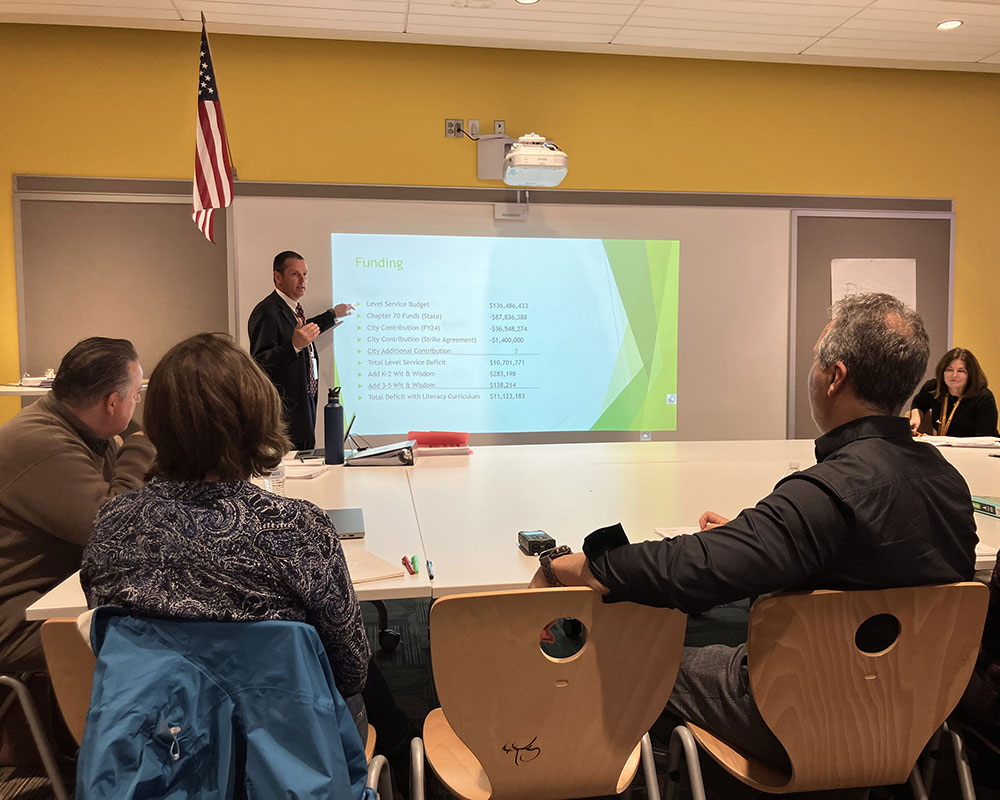Haverhill Public Schools, which serve around 8,000 students, is working to reduce a projected shortfall of $11.1 million as it begins to put together a budget for the year that starts July 1.
In a presentation to Haverhill School Committee members on next year’s finances, Assistant Superintendent Michael J. Pfifferling explained the stark reality at a budget workshop last week. Though technically the deficit is $10.7 million, the Wit & Wisdom literacy program has been deemed essential and costs a little more than $400,000.
The district’s “level service budget” is $136,486,433. The phrase means this is the amount of money needed to provide the same level of services as last year. The state will contribute $87,836,388 for next year, and the city gave $36,548,274 last year, with an additional $1.4 million for the 2022 teachers “strike agreement.”
It is not yet known how much additional money the city may provide, though Mayor Melinda E. Barrett commented during the workshop, “this budget is reflective of the larger budget.”
The largest chunk of the deficit, Pfifferling told WHAV, comes from the loss of $8.7 million in American Rescue Plan Act money as the federal pandemic aid program ends. Though the district was aware the source would dry up, it expected more state money.
Pfifferling questioned the low inflation estimates the state uses to determine state education aid, known as Chapter 70. Inflation is estimated by how much prices across the economy increased. While the district received an $8.5 million increase in aid last year, it is now expected to receive only $5.2 million this year.
“They’re looking at one inflationary number in an aggregate, but they’re not looking at the individual pieces, of transportation, of special education, of salaries—we have a lot of negotiations going on, we’ve seen what’s going on around the state,” Pfifferling said at a school committee meeting last month.
As WHAV reported, transportation costs have increased because the federal government mandates districts bring homeless students to and from school, regardless of where they are staying. The cost this year, expected to be over $1 million through June, is more than double what the district paid last year. Pfifferling speculated the state lifting its pandemic-era moratorium on evictions has brought on this spike in unhoused students.
Though the largest absolute cost increase is from teacher salaries, at $4.9 million, they also make up a majority of the budget. Compared to last year, they increased by 7.9%, which is accounted for by 3% across the board for cost of living and year-by-year raises.
To determine what could be cut, Superintendent Margaret Marotta had principals from across the district separate services into three categories. During last week’s budget workshop, Pfifferling presented on the “green” options.
“Green—I hate to cut it, but I can probably live without it,” Pfifferling said, explaining the category. “Yellow—really can’t live without it, but if something has to go, it’s the middle of the road. And red is, you just can’t take this away from me. I can’t operate my building, I can’t operate my department, without this particular type of thing.”
Proposed “green” cuts included $250,000 from reducing the size of the summer school program, $455,900 by paying for summer school essentials with grant money, $160,000 by cancelling Camp Tricklin’ Falls and $226,771 from curriculum cuts that would not impact learning quality. The superintendent also suggested hundreds of thousands in instructional supply cuts—not buying, for example, sensory stimulation items that might help kids focus.
The last three items from the first round of savings were $422,171 in “non instructional salaries,” $368,100 in “student support salaries,” and $478,322 by not filling open teaching positions.
Pfifferling said non-instructional employees “do not have direct interaction with students. They may have interaction with students, but not in the classroom for the most part. Don’t want to get too far into what [the budget item] entails.”
Marotta explained, “almost all of those, not necessarily the non-instructional, but the student support salaries, those are open positions. So, principals said, ‘you know what, I don’t have it now, I just won’t have it next year.’”
By dipping into a “rainy day” fund, using some grant money and taking advantage of savings from last year, total round one cuts makes up $6.3 million of the $11.1 million deficit. Marotta asked for guidance from school committee members as she works out the “yellow” and “red” recommendations for the next budget workshop, which is set for March 21.
“That’s one of the questions that this group is going to have to help us decide,” Marotta said. “Is one of our solutions to up class sizes a little bit? Or do we want to keep class sizes where they are, and eliminate something else? It seems like we have a series of bad choices to make.”
School Committee Vice Chairman Paul A. Magliocchetti was the first to weigh in, making clear that, in his mind, teachers should not be considered.
“I don’t think we have, at this point, gone to any teachers,” Marotta responded. “We’re desperately trying to avoid the people who touch the children every day,” he said.
Much of the money from the American Rescue Plan Act went toward adjustment counselors, other interventionists, special education teachers, multilingual learner teachers, and expanding summer programs, Marotta explained. Members debated the value of continuing to address the mental health crisis as opposed to ensuring a top-tier education, and they asked for data on the role of adjustment counselors for future discussions.
